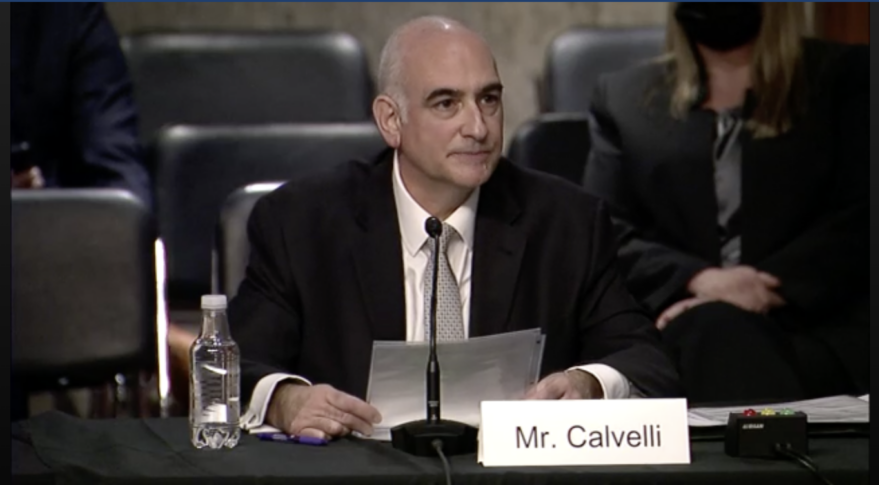Integrating commercial partners and priming an ever-accelerating development and acquisition process will define the future for Pentagon space programs, acquisition leaders predicted at the 2023 GovCon Wire Space Acquisition Forum on Jan. 18.
Keynote speaker Frank Calvelli, assistant secretary of the Air Force for space acquisition and integration, reiterated the nine guiding “tenets” of the acquisition process he unveiled in 2022. These include smaller and more resilient satellite systems, using existing technology, fixed-price contracts, and a start-to-launch period of no more than three years. He also emphasized using commercially available resources where possible.
“There’s no better way to make capability available faster than just to take advantage of what’s out there commercially today,” Calvelli said. “Whether that’s military satellite communications over commercial communications networks based on an awareness or even [a] commercial launch, leveraging commercial services at speed diversifies the architecture and adds resiliency.”
Inherent in this process, however, is the challenge of placing evolutionary technological development within a defined rapid acquisition construct.
Panelist Kelly Hammett, director and program executive officer for the Space Rapid Capabilities Office within the Space Force, argued for more objectivity on how certain systems may mature within this complex process. Though he agreed that working through Calvelli’s rapid acquisition model is effective, it has limits.
“That only works when you can go buy stuff that’s already been developed,” he said. “When we get some of our highly classified Space Command-driven, urgent priorities, the first thing is [to] understand that requirement very well, understand the maturity of the solutions that are potentially available, and … that drives your acquisition strategy,” he said.
Ultimately, Hammett said the goal is to ensure the requirement is correct.
“Essentially having a trade space in that requirement with a minimum viable product, and some room to trade cost performance schedule, is really key to setting up the program right,” he said.
Integral to this process, Hammett added, is having the right people in the right place to take advantage of all available tools.
He applauded Calvelli’s institution of quarterly portfolio reviews with metrics in space acquisition, noting that tracking those key leading indicators can keep the process on schedule. In addition, Hammett emphasized increased communication and interoperability, which has broken down some barriers in the process.
“When you have stovepipes and different decision processes in governance, you start to diverge,” he said. “That’s one other best practice that we’re starting to use, and it’s paying some dividends, but there’s a way to go on this.”
Gordon Kordyak, deputy director of the space programs directorate for the Air Force, agreed and said he’s focused on resilience and how to operate in a contested environment with emerging threats. Open dialogue and communication, he added, are crucial to ensure all players in the acquisition realm share a common understanding of what’s occurring throughout the process.
“We have to have a discussion about how requirements can be traded, how can requirements be thought of in a way to inform acquisition strategies such that we can take risks together as an operational community and acquiring community,” he said. “And most importantly, we’ve got to communicate about where we’re at in that progress [and] have transparency and an open discussion about when things go right [and] when things go wrong.”
Part of that discussion is “what is possible versus what is possible right now,” he added.
Col. Edward Ferguson, deputy director of space and missile defense in the office of the undersecretary of Defense for acquisition and sustainment, said his team is looking at the acquisition process from an entire mission perspective. Part of that focus is ensuring on-time delivery and integration to ultimately help the warfighter.
“Commercial plays a huge part of that,” he said. “What it does is it allows us to quickly fill any kind of capability gaps that we may have; it allows us to look at where the DOD doesn’t need to go develop something.”
He noted that he’s seen a paradigm shift in the department, from a force behind in capability development to one that utilizes capability and enjoys the flexibility this provides to meet government needs. It’s prompted department-wide changes.
“A couple of really big changes that we’ve made within the department are the adaptive acquisition framework, and then also changing the milestone decision authority for a lot of our space programs down to the service acquisition executive,” Ferguson said. “Those two big changes allow us as a department to move faster to deliver that capability.”
Barbara Baker, deputy program executive officer at Space Systems Command, added that she’s seen the commercial market advance capabilities beyond imagination.
“What we’re up against now is really trying to break down walls to realize we have to be more integrated between what industry is doing with commercial to what specifically we need to go build for very specialized programs,” she said. “There is a trade space that has opened up, and we need industry’s help to educate us on all the capability out there, and even for our big prime defense contractors to be working with commercial to realize those opportunities.”
She added that this is not a “one-size-fits-all” proposition, and it’s crucial to determine the best paths to utilize available capabilities, particularly with the timelines that weigh so heavily on the process.
“Getting after the commercial piece is really being able to figure out how to leverage their capability while also meeting government networks’ specific warfighter needs and trying to figure out how to sort of build that capability to its maximum use, while then figuring out what is the remaining sort of subset of requirements,” she said. “That’s a ‘build only what we must,’ and it is definitely a mindset change.”
